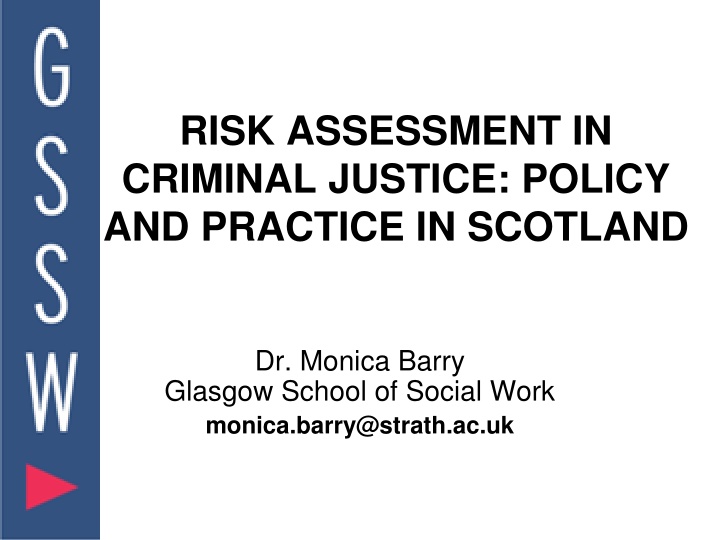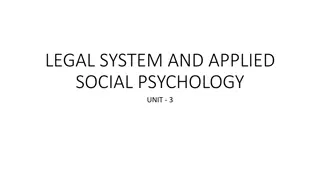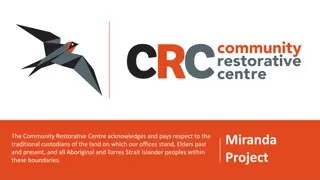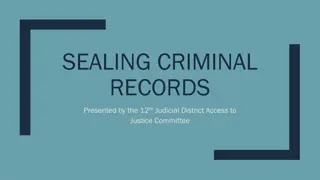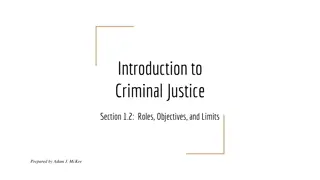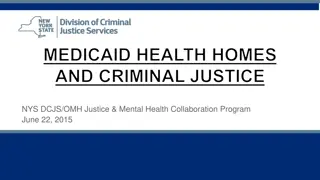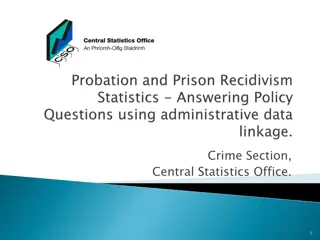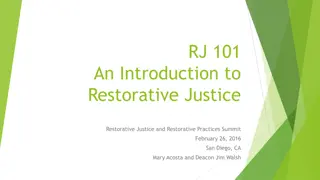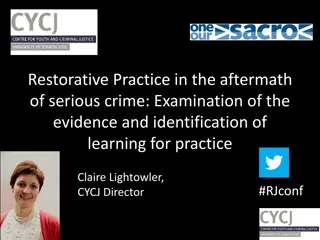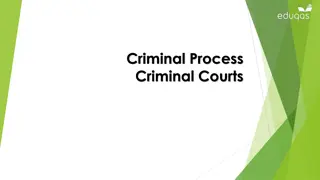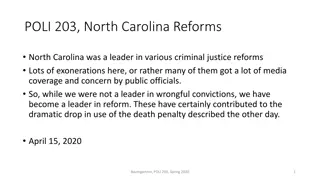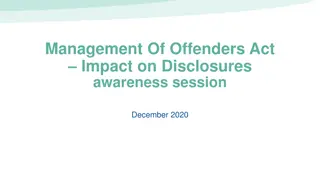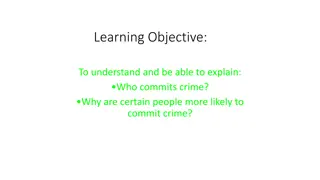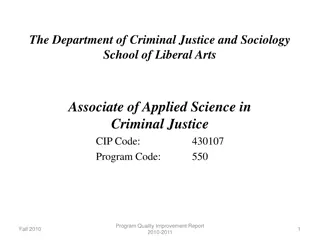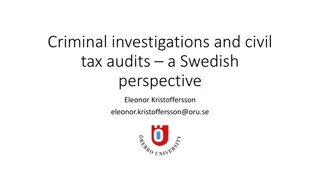Risk Assessment in Criminal Justice: Policy and Practice in Scotland
This content delves into stakeholder perceptions of risk in social work, issues in criminal justice policy and practice, and definitions of risk. It explores different models of risk assessment, who is affected by risk, and organizational cultures in decision-making processes. The content also discusses the importance of formal procedures in guiding practice within organizations to ensure due diligence and protection of children.
Download Presentation

Please find below an Image/Link to download the presentation.
The content on the website is provided AS IS for your information and personal use only. It may not be sold, licensed, or shared on other websites without obtaining consent from the author.If you encounter any issues during the download, it is possible that the publisher has removed the file from their server.
You are allowed to download the files provided on this website for personal or commercial use, subject to the condition that they are used lawfully. All files are the property of their respective owners.
The content on the website is provided AS IS for your information and personal use only. It may not be sold, licensed, or shared on other websites without obtaining consent from the author.
E N D
Presentation Transcript
RISK ASSESSMENT IN CRIMINAL JUSTICE: POLICY AND PRACTICE IN SCOTLAND Dr. Monica Barry Glasgow School of Social Work monica.barry@strath.ac.uk
stakeholder views and perceptions of risk across social work the Changing Lives agenda key issues for policy and practice within community care and child protection issues and tensions in policy and practice in criminal justice concluding remarks
DEFINITIONS OF RISK risk as the chance (rather than likelihood) of being exposed to harm (Little et al., 2004). risk as the uncertain prediction of future behaviour or events producing a negative outcome (Kemshall & Pritchard, 1996). Risk as the undesirable conduct of certain groups rather than the feared negative outcome for others (Rose, 2000).
Models of risk assessment the risk-taking model - positive outlook - focus on wellbeing, rights, abilities, choice - therapeutic and constructive the risk-minimisation model - negative outlook - focus on danger, health risks, disabilities, containment and control - information-gathering, boundary-setting and back-covering
WHO DOES THE RISK AFFECT? the client, in terms of self-harm; the public, in terms of harm to others; the agency, in terms of litigation, adverse publicity and political implications.
Organisational cultures non-participation versus participation in decision making culpability versus absolution prediction versus response
the organisation introduces more and more formal procedures to guide practice so that they create a correct way to deal with a case. Then, if a tragedy occurs, they can claim the defence of due diligence and show that their employees followed these correct procedures in working on the case. A child may have died but the agency staff can show a clear audit trail of what they did In a defensive culture, the protection of the agency can start to dominate over the protection of children. (Munro, 2004: 880).
CHANGING LIVES OBJECTIVES clearer accountability frameworks; strengthening professional leadership and governance; structured learning from mistakes; a common language of risk; and evidence-based approaches to risk assessment. (Scottish Executive, 2006)
Community care user empowerment - exposure to unmet need - wish to take appropriate risks - be part of the risk assessment process risk assessment tools - inaccurate, time-consuming, cannot accommodate diversity organisational culture - allocate blame - risk-averse - reactive rather than proactive
Child protection user empowerment - legislation protects against undue intervention - respecting the rights of families versus the rights of the child risk assessment tools - actuarial, time-consuming and restrain relationship-building - false positives and false negatives - an air of authority organisational culture - focus on forensic evidence and prediction - allocate blame
POLICY AND PRACTICE IN CRIMINAL JUSTICE If [parole] had been any longer, I think I d have handed myself back in, to be honest with you (38 year old male). [Life licence:] It s like walking on ice all the time (35 year old male). [Probation:] It just gives you more rope to hang yourself (18 year old male).
Multi-Agency Public Protection Arrangements (MAPPA) England and Wales: convicted and unconvicted offenders Scotland: convicted sexual or violent offenders; those acquitted on grounds of insanity; other convicted offenders at risk of serious harm
MAPPA levels Level 1 ordinary risk management mainly managed by one agency; Level 2 local inter-agency risk management needing active involvement of more than one agency Level 3 Multi-agency public protection panels for the critical few high or very high risk offenders, requiring senior management involvement
ISSUES defensible decision making the politics of risk bifurcation rehabilitation v. managerialism accountability
Defensible decision making making the most reasonable decisions and carrying them out professionally in a way that can be seen to be reasonable and professional (emphasis added) (Home Office MAPPA Guidance, 2006) a responsible body of co-professionals would have made the same decision (Social Work Services Inspectorate).
DEFENSIBLE DECISION MAKING Take all reasonable steps; Use reliable risk assessment tools; Collect and thoroughly evaluate information; Record and account for decisions; Follow agency policies and procedures; Ensure decisions are grounded in evidence; Match risk management to risk factors; Maintain contact with the offender at a level commensurate with the risk; and Respond to escalating risk, deteriorating behaviour and non-compliance. (Kemshall, H.,1999; Kemshall, H., 2003)
The politics of risk Politics and economics v. welfare and need The manipulation of crises to justify policy implementation Individual deficits rather than structural change
Bifurcation separating out and targeting those at high risk at the expense of the rest primarily a resource-rationing device to gauge priorities an assumption of cost-effectiveness
Rehabilitation versus managerialism worker-client relationship versus a tick-box mentality hypermanagerialist approaches to the micromanagement of offenders (Nellis, forthcoming) Operating in a professional vacuum, devoid of a worker-client relationship
Accountability how rather than why interventions are planned inter-agency working reduces the likelihood of one agency being held accountable when things go wrong
Accountability in the Treasury outcomes; roles and responsibilities; performance expectations; review of performance; intervention if performance slips; incentives for improved performance; flexibility of objectives/priorities; recognising and learning from achievements/difficulties; communication of performance across the whole organisation.
CONCLUSIONS Risk assessment and management should be about maximising opportunities for change whilst minimising opportunities for harm
accurate empathy, respect, warmth and therapeutic genuineness; establishing a therapeutic relationship involving mutual understanding and agreement about the nature and purpose of intervention; person-centred and collaborative working, taking into account the client s perspective and using the client s concepts (McNeill et al., 2005).
IMPLICATIONS need to adopt a more participative, holistic and proactive approach; users should be seen as equal if not primary partners in the process and outcomes of risk; need to find ways of better developing trust, reciprocity, respect and integrity between all parties; policy and practice need to demonstrate confidence and commitment to encouraging rather than restricting capacities and well being.
Future research Explore the views of clients, practitioners and policy makers about what constitutes risk, and its assessment and management; Explore the levels of coercion versus consensus in risk assessment and management for clients and practitioners; qualitative research on differing cultures and organisational approaches to risk across agencies.
